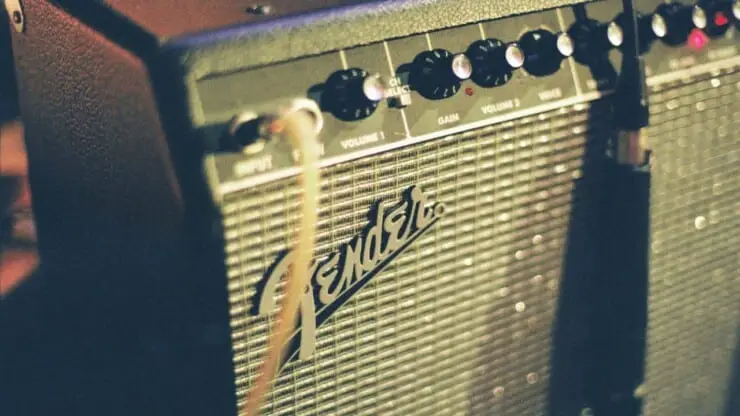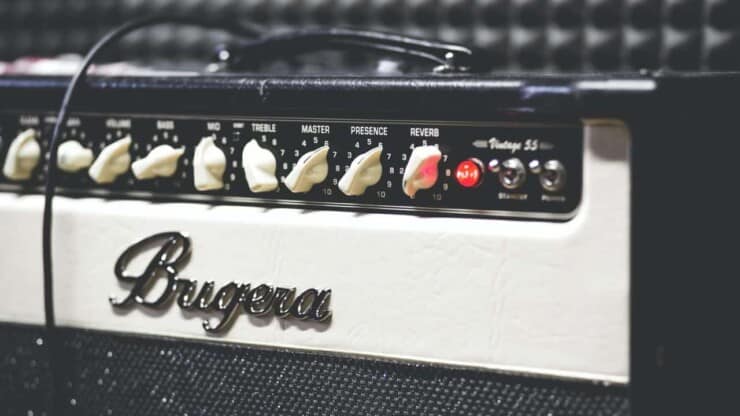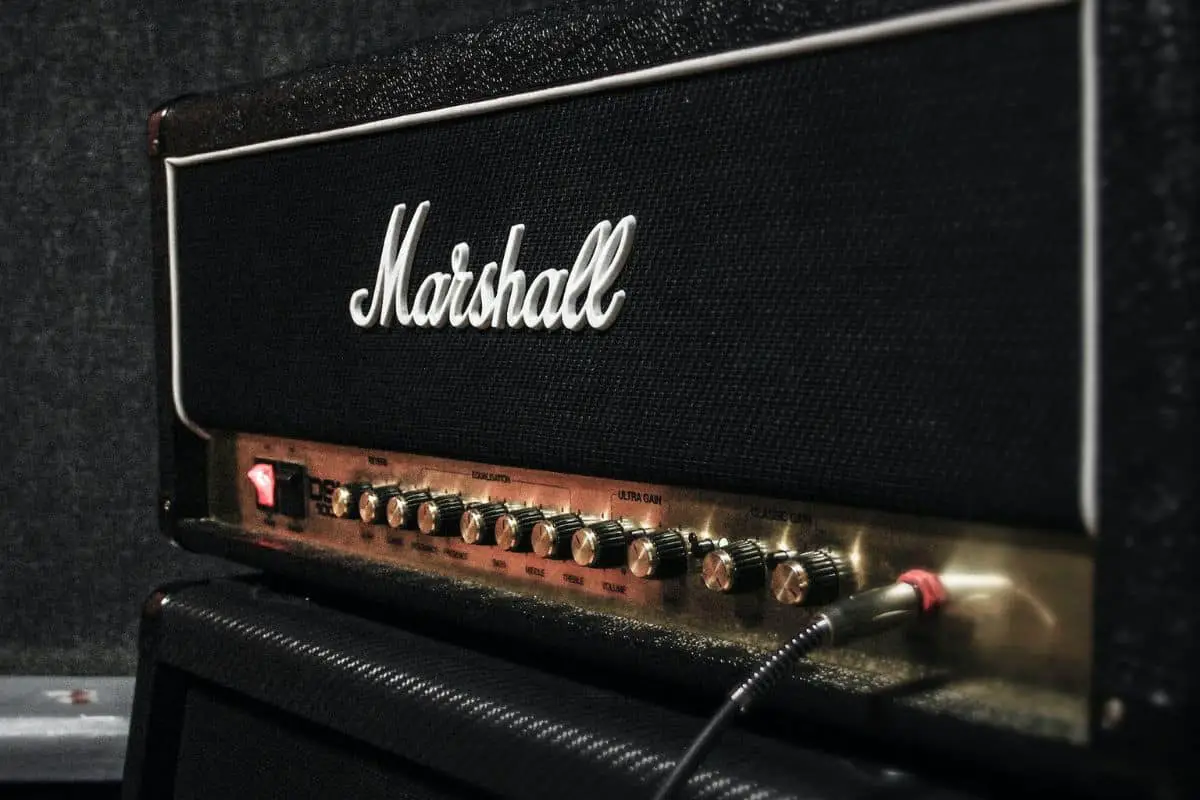Have you been having trouble with your amp, making you wonder why won’t my guitar amp work? If so, then you should not panic because there are reasons amps sometimes stop working.
Guitar amp not working properly is not as big a problem as many think. There are many reasons why amps might not work properly such as having humming or buzzing sound, muffled noise, fuse issues, and more.
In this article, you’ll get to know the answers to why isn’t my guitar amp working, why won’t my guitar amp make sound, why won’t my electric guitar connect to my amp, and more. Stick around for all the answers.
Why isn’t my guitar amp working – Preliminary troubleshooting
Always go for the divide-and-conquer route. Is the tone, volume, or master volume control affecting the noise? When the control affects the noise, it generally indicates that the noise is entering the amp before the control. You should always suspect a bad tube, as they’re the most common failure point in a tube amp. Having a spare set of tubes that will swap into the amp one at a time will be important for gigging tube amp users.
A bad tube causes countless different symptoms including signal loss, static, hiss, hum, and more. You name a problem, and a bad tube will likely be the reason for it. Power tubes tend to wear out quicker than preamp tubes, but as they say, all tubes must die. You shouldn’t forget to check the rectifier tubes. These tubes can cause all sorts of problems, including weird noises. Reverb driver tubes sometimes have over 400V on their plates and die quicker than preamp tubes.
Loose or dirty tube socket pins could cause all sorts of hard-to-diagnose intermittent problems including loss of signal, weird noises, red plating, weakening/thinning of signal output, crackle & pop, and loss of tube heat. Sometimes, you can wiggle a tube and carefully look for the noise. You’ll be able to clean the socket by spraying contact cleaner on a tube’s pins and then inserting them into the socket a few times.
Contrary to common beliefs, the power and output transformers are least likely to be the cause of amp problems. You should always try another guitar cable, guitar, speaker cable, or speaker. Ensure that you have a speaker or dummy load connected to the amp each time it is powered up.
Why is my guitar amp not working – Common tube amp malfunctions
The circuitry responsible for turning the amp on and off will be simple. It is simply writing that offers line voltage to the transformer. More commonly, this wiring will provide line voltage to the transformer. More commonly, the wiring is in great shape, voltage is passing through without any problem, the amps are turning up, the bad components inside are receiving the power that the circuit can offer, and the amp starts to malfunction. It’ll be important to distinguish between an amp that isn’t turning on and an amp that isn’t making a sound. Amps not turning on will likely be a power supply issue.
Meanwhile, not passing signals will be more of a general problem that can be located in preamps, power amps, or speakers. If you’re hearing something out of the speaker, even if it is a low hum, the amp is on, and you’re having a no-signal problem.
Steps to diagnose a guitar amp that isn’t turning on
Look for trivial problems
Is the amp plugged in? Are there any tubes present? Is the speaker properly connected? Is the wall output properly working? The wall outlet will be an important one to check. A working wall outlet will be a normal, everyday occurrence. Outlets offer the guitar the needed electricity, and you don’t have to think twice about it. It’ll be a miracle that an old amp can even be plugged in, let alone get turned on.
Basically, when the amp’s outlet fails, it’ll be natural to scapegoat the gear instead. Double-checking the outlet isn’t wishful thinking, instead, it is covering your bases. It’ll be well worth testing the amp in multiple outlets before you begin troubleshooting.
Is the guitar amp’s fuse intact and present?
All guitar amps, except cheap, unsafe vintage models, will have a mains fuse. A fuse is essentially a thin piece of wire that is enclosed in glass. If the amp is working normally, the fuse will complete the circuit like any other component of the wire. If the circuit experiences an inrush of excessive current, the wire inside the fuse burns up, and the amp powers off, just as if you had hit the switch. The fuse is normally mounted somewhere around the power cord and inside the fuse holder with a plastic cover.
In some amps, for instance, the 200 and 200a, the fuse will be hardwired into the amp and should be replaced by a technician. Although, you’ll first need to unplug the amp and be sure that you avoid touching any circuit components.
Never replace the fuse with one having a larger current rating than the amp calls for
If no fuse is present, the amp, the amp will not be able to work. Fuses are inexpensive and can be purchased at hardware stores, making it trivial to replace them. However, in case the amp is new, an absent fuse will be a cause for suspicion. It’ll be possible that the fuse is missing, as it blew the last time you powered the amp. However, the fuse may even be missing for some reason. For instance, due to the previous owner removing it and placing it in a different amp.
If the fuse is present but blown, the amp cannot turn on as the circuit providing mains voltage is open. Replacing the fuse might or might not solve the issue. If the fuse blew because of a fault in the mains voltage like a brief power surge, replacing it will probably be sufficient to make the amp work again. However, if you’re placing the fuse and the amp continues to blow, there’s an issue in the amp that needs to be resolved before the fuse gets replaced.
If the fuse is blown, the amp has most likely experienced an excess of current. This excessive current could be inside the amp or outside the amp. For instance, there might have been a power surge or a fault in the outlet or power cord causing a short. If you’re able to solve the exterior issue (by replacing the power cord or by using a new outlet), you can replace the fuse. If it has done its job and blew before the current damaged other components, the map will work as normal.

On the other hand, if the issue is with the amp, the fuse continues blowing until the fault gets addressed. Faults that blow fuses tend to include a short in the tube or transformer or a short in the AC or high-voltage wiring. For finding the short, you need to remove as many components as you can from the circuit for isolating the problem area. One way of doing this is by plugging the amp into a lightbulb current limiter and then removing the tubes.
If the bulb glows without any tubes installed, this will indicate that there is a short present in the circuit. If it does not glow, replace each tube one by one with the amplifier switched off. If the blub starts glowing after you’ve replaced the tubes, the short was in the tube.
It’s important to remember that operating the amp when it is shorted can be very dangerous. Tests should only be conducted if you’re experienced enough and have the capability to do so safely. Otherwise, you should call upon a technician to take over at this point.
If the fuse is present and doesn’t seem to be blown, you should use a multimeter. It’ll allow you to confirm if the fuse is still good. A decent fuse will have proper continuity across the terminals. It can be quite hard to see the break in the fuse visually, so you should test it with a multimeter if you aren’t certain.
If the fuse isn’t blown and the amp isn’t turning on
In case the fuse is intact, but the amp still isn’t turning on, it’s likely that some part of the circuit is disconnected or open. If the amp is showing no signs of life, the problem will probably be early in the power supply. It can even be in the power transformer primary. Interruptions in the wiring will be more likely to create a bottleneck for preventing the rest of the circuit from receiving enough voltage.
As for the other side of the power transformer (the side with the audio circuit), the voltage will branch off in different directions. It powers off different parts of the circuit that allow you to hear some sort of white noise or hum. Sometimes, it is audible even if the audio signal is cut off.
For that reason, you should pay close attention to the AC connections on the primary side of the amp’s transformer. It includes the power receptacle, switch, fuse holder, pilot light, and transformer. A frayed wire or broken solder joint might be interrupting the voltage. Sometimes, some parts of the circuit might be unintentionally grounded as well.
With the amp unplugged, you should use the continuity feature on the multimeter for ensuring that all the wires, including the power cord, are having appropriate continuity. Make sure that the switch is having continuity when it’s in the “on” position.
Moreover, make sure that the wires leading to the rectifier are in proper shape and solidly connected. Find out the power transformer center tap and then confirm that it is properly grounded. Some amps have additional fuses near the rectifier or the power transformer secondary. Check if they’re blown. Keep in mind that you should discharge the filter capacitors before you replace secondary fuses, make continuity tests, or work inside the amp.
Check the power transformers for open windings
If the wirings check out, the power transformer should be checked for open windings. Is it offering the expected voltage to the rectifier? These tests will be more advanced as they might involve taking voltages while the amp is running. You may even have to do the same while disconnecting the components to get more accurate readings. If you’re a beginner, you shouldn’t risk it and contact a technician to resolve this issue.
Check for tube glow
If your amp uses tubes, you should check for tube glow. This will indicate that the power transformer’s heating windings are functioning. Depending on the particulars of the tube, the heater glow might be obvious or slightly faint. In some amps, the rectifier tube will be on a separate winding. The heater glow will imply that connections on the transformer primary are working sufficiently for energizing the heater winding. If the amp appears dead but still has a heater glow, you should focus on the high-voltage secondary and the rectifier circuit.
Guitar amp producing hum and buzz sound
You should start off with the basics. Is the volume or master control influencing the hum or buzz? If so, then the noise is entering the circuit before the control. Is the noise present on both channels? If yes, then the noise is coming into the circuit after the channels have merged. If no, then the noise is entering upstream of the channel merge.
In case the amp features an FX return jack, plug your guitar there and see if the noise is still present. If there is no noise, you’ll know that the noise was coming from the upstream of the FX return jack.
The loud hum from newly built amps is often caused by bad or missing ground. You should look for continuity between everything that needs to be grounded and the chassis. A joint without solder can result in an intermittent loud hum. You should inspect every solder joint using a magnifying glass. It’s common to leave a couple of joints without solder. Hum and buzz can be caused by the chassis being improper and open to environmental electromagnetic noise.
Make sure that you’re trying another guitar and guitar cable to confirm the issue. Moreover, try the amp in other locations, as sometimes noise can be caused due to dirty power. It can even be caused by radio frequency interference from cell phones, fluorescent lights, noisy light dimmers, and other electrical equipment. Before taking off the cover from the amp, try it in another location, if possible in another building.
An input jack whose switch tab isn’t making contact when the guitar isn’t plugged in can cause a loud hum or buzz. You should try and push the switch tab closed and observe if it kills the noise. This is even more evident when plugging in the guitar decreases amp noise. In combo amps, the speaker, cab, or speaker baffle can rattle, vibrate, and buzz. Try to sit on the cab or put pressure on different parts of the cab, speaker frame, or speaker baffle.

A dying tube could create a 50-60Hz hum from heater cathode leakage, but can even cause a 100-120Hz hum. Swapping each tube must be done before you go any further. You’ll be surprised that swapping the preamp tubes will help you get rid of loud hum, even if they’re brand-new tubes. After trying different tubes, the next step would be to identify the type and frequency of the buzz or hum. Buzz is a sharp tone, while hum is a smooth sound. A “buzz” is usually caused by noise that can be seen on oscilloscopes as waveforms with sharp spikes.
In the United States, hum and buzz normally come in two frequencies, 60 and 120Hz. If your power is running at 50Hz like in Europe, you’ll have 50Hz and 100Hz hum and buzz. Determining the frequency of the noise helps in tracking down the source. 50 and 60Hz hum generally comes from the power transformer, heater wires, or fixed bias circuit. 100 and 120Hz hum tends to come from the power supply after the rectifier.
Dirty, loose, or corroded tube socket pins can result in hum and buzz. You’ll be able to clean them by spraying contract cleaner on tube pins and inserting them into the socket a few times. Microphonic tubes can rattle, buzz, and even ring. Touching the tubes gently with a gloved hand or a chopstick while playing something that makes it buzz will help you identify the bad tube. A hot power tube bias could cause a loud hum. A large bias imbalance between the power tubes could cause a 60Hz heater hum.
Inspect the speaker connections on both ends of the speaker cable. Slide-on spade connectors could make an intermittent connection and result in buzz, static, and audio dropout. Not everyone likes spade connectors – solder that speaker cable to the speaker terminals, as you’ll be able to blow the output transformer and/or power tubes if the connections break.
Adding copper or aluminum foil tape to an amp cab for covering the chassis opening helps in reducing RFI. The tape should make good contact with the chassis. Only then will it be able to act as an RFI shield. For instance, for amps like the 5E3 Deluxe and other tweed amps, the tape must be applied to the inside of the wooden back panel for covering the chassis opening.
For more modern Fender amps, you can always apply the tape to the underside of the top of the cab. Connecting the power transformer high voltage center tap to the first filter cap negative terminal directly might reduce hum and buzz. This is possible as it’ll minimize pulsing 120Hz ground return current.
Conclusion
Thank you for reading. Hopefully, now you have the answers to questions like why aren’t my guitar amp working, why won’t my guitar amp make sound, why won’t my electric guitar connect to my amp, and more. If your guitar amp isn’t working properly, then don’t worry, as it is a common issue faced by most guitarists. Look for the source of the problem and troubleshoot the issue. There are many reasons why your amp might not be working. Some common ones include a bad tube, loose wiring, broken components, and more. It might result in fuse issues, humming and buzzing sounds, bad overall tone, and more.



